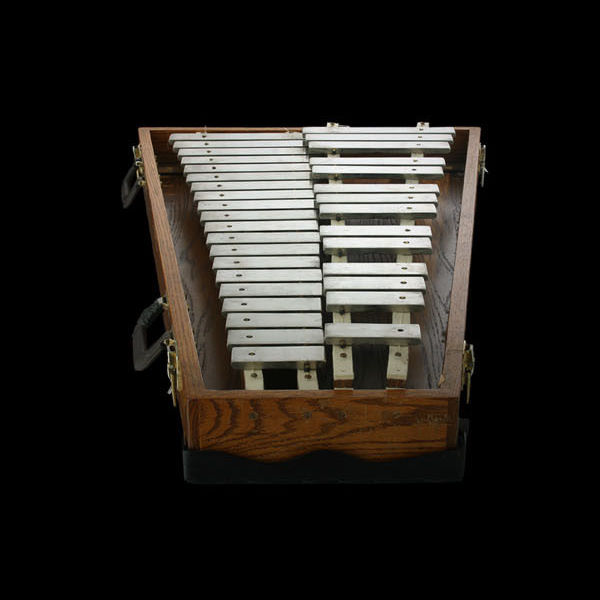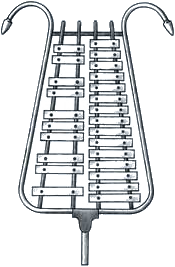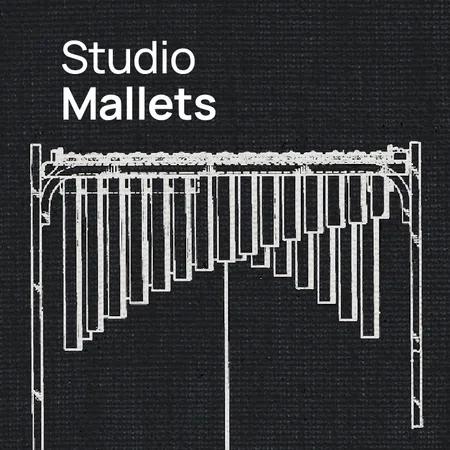
Name: Glockenspiel (orchestra bells)
Spelling
German: Glockenspiel
French: jeu de timbres, carillon
Italian: campanelli
Classification: Idiophone, metallophone, percussion instrument with definite pitch, mallet instrument
Metal Bars: Steel alloy; Width: 2.5–3.1 cm; Thickness: 0.5–1 cm
Table-shaped frame: Dimensions: approx. 76 x 36–46 cm; Height: 5–8 cm
Stand – The “open glockenspiel": Metal stand; height is adjustable (81–94 cm), usually on wheels. The stand of the open glockenspiel is partly enclosed in the case. The table glockenspiel is placed on a table.
Resonator: The case acts as the soundbox (resonator)
Weight: 5–12 kg
Damper pedal: Glockenspiels on a stand usually have a damper pedal, table glockenspiels do not.
Tuning: Equal temperament, the tuning tone is generally 442 hertz
The name glockenspiel is German and means "bell play"; it refers to the sound of small bells. The very first instruments to carry this name did indeed consist of a set of small bells which were played either by a group of musicians or struck by means of a complicated mechanism. At the end of the 17th century steel bars began to replace the bells. Initially only a substitute for real bells, this arrangement of metal bars soon developed into a musical instrument in its own right and retained the name "glockenspiel".
Like the xylophone, the glockenspiel is also a great favorite with children. Carl Orff used it from the 1930s for his Method. Children's instruments have a smaller range, are tuned diatonically and have bars resting over a frame like a trough. They are made in various ranges. Lower-pitched glockenspiels have short resonators and are generally known as metallophones.
Discover our Glockenspiels
Name: Glockenspiel (orchestra bells)
Spelling
German: Glockenspiel
French: jeu de timbres, carillon
Italian: campanelli
Classification: Idiophone, metallophone, percussion instrument with definite pitch, mallet instrument
Metal Bars: Steel alloy; Width: 2.5–3.1 cm; Thickness: 0.5–1 cm
Table-shaped frame: Dimensions: approx. 76 x 36–46 cm; Height: 5–8 cm
Stand – The “open glockenspiel": Metal stand; height is adjustable (81–94 cm), usually on wheels. The stand of the open glockenspiel is partly enclosed in the case. The table glockenspiel is placed on a table.
Resonator: The case acts as the soundbox (resonator)
Weight: 5–12 kg
Damper pedal: Glockenspiels on a stand usually have a damper pedal, table glockenspiels do not.
Tuning: Equal temperament, the tuning tone is generally 442 hertz
The name glockenspiel is German and means "bell play"; it refers to the sound of small bells. The very first instruments to carry this name did indeed consist of a set of small bells which were played either by a group of musicians or struck by means of a complicated mechanism. At the end of the 17th century steel bars began to replace the bells. Initially only a substitute for real bells, this arrangement of metal bars soon developed into a musical instrument in its own right and retained the name "glockenspiel".
Like the xylophone, the glockenspiel is also a great favorite with children. Carl Orff used it from the 1930s for his Method. Children's instruments have a smaller range, are tuned diatonically and have bars resting over a frame like a trough. They are made in various ranges. Lower-pitched glockenspiels have short resonators and are generally known as metallophones.
The instrument now known as the glockenspiel is a hybrid, resulting from the fusion of two different types of instrument, the "genuine" glockenspiel with real bells, and the metallophone .
The "genuine" glockenspiel consists of a set of bells of various sizes. One or more musicians play several overlaid melodic phrases. Exactly how many musicians are required depends on the size of the instrument. This style is known as carillon playing. Strict regulations and local tradition govern the order in which the notes are played. In Germany the playing of fixed bells in church or town hall belfries is known as Beiern. In many places the sequence of notes is played by an automatic mechanism which is operated by a clockwork motor. This type of music is still very much a vital part of local tradition in many areas and a great tourist attraction. Smaller glockenspiels worked on the same principle.
Metallophones have been played in eastern Asia for more than 1,000 years; the saron and the gendèr, for instance, still perform a crucial role as melody instruments today. Metallophones were first mentioned in Europe in the middle of the 18th century. These instruments had a compass of more than three octaves, the bars were made either of the same metal as bells, or of silver, and were already arranged in the manner of a piano keyboard. The mallets had heads made of wood.
In China, bells were already part of the orchestra 4,000 years ago. In the 9th century hemispherical, pear-shaped bells were widespread among occidental monks. These instruments, known as cymbala, featured small, round bells made of bronze which were suspended from a rail and struck by one or two musicians.
In the 14th century there were two types of glockenspiel: large instruments in church towers and smaller ones for playing at home. In the 17th century smaller glockenspiels began to be fitted with a keyboard which made it possible to perform more demanding parts.
The first step toward the glockenspiel used in the modern orchestra was taken by the Dutch in the 17th century. They replaced the unwieldy bells with a row of bars after the fashion of the metallophone from eastern Asia.

*Bell lyre*
The first composer to write for the glockenspiel in the orchestra was Georg Friedrich Handel, who included it in his oratorio Saul (1739). The instrument he used was called a carillon and had a range of two and a half octaves. It had metal bells (or bars) which were played via a chromatic keyboard. The sound was purportedly like that of metal hammers beating on anvils. Handel wrote parts for the instrument in several of his operas.
For The Magic Flute (1791) Wolfgang Amadeus Mozart had a glockenspiel which was largely the same as the one Handel had known. He used it to characterize Papageno, the birdcatcher (magic bells).
Because it was more practical, the Dutch idea of replacing the sophisticated construction of bells with simple bars was widely adopted in the first half of the 19th century. The result was the keyboard glockenspiel; the bars were struck by small hammers operated by keys. This instrument made it possible to perform parts which had hitherto been written in keyboard style.
Shortly afterward the mallet-played instrument was developed to improve the tone, the bars of this instrument being struck by hand-held mallets (beaters). The tone of the mallet-played glockenspiel is superior to that of the keyboard instrument.
From the mid 19th century both types were found in the orchestra, but 20th century composers increasingly preferred the mallet-played instrument because of its superior tone. Nowadays the keyboard glockenspiel, or the celesta which was invented in Paris in 1886 by Auguste Mustel, is used to perform older parts containing chords and particularly demanding glockenspiel parts.
In wind bands the bell lyre is used. This portable version of the glockenspiel was developed for marching bands and was already widespread in Germany in the 19th century. Today the instrument is used in many countries, especially the USA. The instrument is so called because its frame is shaped like a lyre, a stringed instrument of antiquity.
The chromatically tuned bars lie in two rows, in the manner of piano keys, in a shallow wood box which is either mounted on an adjustable metal stand (the open glockenspiel) or simply placed on a table. All the bars are the same width and thickness; it is only the length that varies. The bars are held in place in one of two ways:
Each bar has a round hole in one end with a pin through it. The other end rests on a felt rail. This arrangement is found only on the table glockenspiel.
As on the xylophone, the steel bars have holes drilled in the sides at their nodal points, about 22% of the bar length from the end. A string passes through these holes on which the bars are suspended. Each bar is separated from its neighbor by pegs, which stabilize it and allow it to vibrate freely. This means of suspension is a result of acoustic considerations: because the points of contact between the bar and the rail (or the position of the holes) are located exactly at the nodal points the damping of harmonic partials is prevented, while the resonance of inharmonic partials is hindered. The harmonic partials lend the tone greater clarity. This arrangement is found only on glockenspiels with a damper pedal.
The glockenspiel has no additional resonators since the case acts as a soundbox.
A "piano-action" glockenspiel has a mechanism with small metal hammers beneath the bars which are operated by means of a keyboard. Damping occurs as on the piano, the dampers being raised by depressing a pedal. Although these instruments offer a greater variety of playing techniques than the mallet-played glockenspiel, the sound is inferior. It is for this reason that keyboard glockenspiels are only rarely used today.
The bars are not arranged horizontally but are held vertically in a frame which has the form of a lyre. This portable version of the glockenspiel was developed for marching bands and was already widespread in Germany in the 19th century. Today the instrument is used in many countries, especially the USA.
Percussionists have a choice of mallets of varying hardness.
Hard (metal) mallets emphasize the higher partials, making the timbre brighter, harder and shriller.Softer (wood) mallets damp the higher partials, the timbre becomes softer and rounder and contains more fundamental.
Material: (Hard) plastic, hard glass, brass, metal
Diameter: 1.4 – 2.8 cm. Shaft:
Length: 24 – 37 cm
Head diameter: 1.4 – 1.8 cm, shaft length: 24 – 28 cm Wood:
Head diameter: 1.4 – 1.8 cm, shaft length: 25 cm Wood ebonite with brass core:
Head diameter: 1.4 – 1.8 cm, shaft length: 25 cm Lexan, ABS, hard rubber:
Head diameter: 2.4 cm Approximate categorization according to head size
Up to 2 cm = small, 2.5 cm = medium, 2.8 cm = large
Transposing, notated on one system in treble clef.
As a rule the mallet-played glockenspiel sounds two octaves higher than written. However, notation in many scores is only one octave lower (e.g. in Richard Wagner).
There is often no indication in the score of whether the notation is one or two octaves lower than the sound. In such cases the musician must take the register and range of the passages as a guide.
A transposing instrument notated on two systems both written in treble clef.
The keyboard glockenspiel generally sounds one octave higher than written.
Three-octave mallet-played glockenspiels are usual in the symphony orchestra.
Two and a half octaves
- G5 – C8
- F5 – C8
Three octaves
- F5 – F8
- C5 – C8
Keyboard glockenspiel
- C5 – C8
The glockenspiel comprises two parallel rows of chromatically tuned steel bars. Each bar has its own pitch which is determined by the length: the shorter the bar, the higher the pitch.
The bars are arranged in the same order as the keys of a piano.
The musician holds two to four mallets, the palm of the hand facing downward. The striking spot is almost in the middle of the bar.
The bars have a high density which aids the projection of the tone. Relatively heavy mallets are therefore necessary to cause the bars to vibrate.
Percussionists have a choice of mallets of varying hardness.
Hard (metal) mallets emphasize the higher partials, making the timbre brighter, harder and shriller.
Softer (wood) mallets damp the higher partials; the timbre becomes softer and rounder and contains more fundamental.
Very heavy mallets produce a distinctly audible percussive attack (dull clack) in loud passages, especially on table glockenspiels.
Individual notes can be damped with the hand following the attack, enabling the musician to determine the length of sustain. Damping with the mallet on the glockenspiel would produce an extraneous noise at the moment of impact. Conversely, damping with the mallet is standard practice on the vibraphone.
Damping is often indicated in the score by (x) after the note.
Notes on modern glockenspiels are damped in the same way as on the piano, i.e. there is a damper pedal which raises the dampers from the bars when depressed, allowing the note to resonate; without the pedal, the notes are automatically damped and sound very short.
Is played like a piano.
Some composers write glockenspiel parts explicitly for the keyboard glockenspiel and include chordal playing which can only be performed on such an instrument (e.g. in W. A. Mozart’s The Magic Flute or Olivier Messiaen’s Oiseaux exotiques). However, because the sound of the keyboard glockenspiel is inferior to its mallet-played counterpart, demanding glockenspiel parts are nowadays usually performed on the celesta.
Single notes are sounds with resonance that can be shortened by being touched with the fingers. Sustain is longer in the lower register. On modern instruments the resonance is shortened with the use of dampers that are connected to a pedal. Depressing the damper pedal raises the dampers and allows the note to resonate (as on the piano).
If the damper pedal is not depressed the bars are damped by a felt rail; in other words, damped notes are produced “naturally", as on the piano. Depressing the pedal raises the dampers. Damped notes correspond to staccato playing. The dynamic range is limited.
Following the attack, a vibrato effect can be achieved on notes with long sustain if the musician moves his or her cupped hand up and down over the vibrating bar. The speed at which the hand is raised and lowered determines the speed of the vibrato.
Repetitions with and without accents are possible.
Trills of all kinds are easy to perform and produce a good effect.
Every type of tremolo, monophonic and polyphonic, is possible. A limited range of dynamic levels is available within the tremolo.
Diatonic (white keys) and pentatonic glissandos (black keys), either singly or together in parallel motion, as well as crosswise glissandos and polyphonic glissandos, are possible and very effective at all tempos and dynamic shading. Fortissimo glissandos are also effective. Pentatonic glissandos are very difficult to play owing to the irregular spacing of the bars. Only round mallets are suitable for performing glissandos.
Glockenspiel parts generally only require one mallet per hand. Chords are produced when the musician uses three or four mallets at once, i.e. two (sometimes three) mallets per hand. The span covered by two mallets in one hand depends on the width of the bars and the length of the mallets.
Tremolo with two mallets in each hand, so that the notes combine to form a static sound.
Adjacent bars are struck simultaneously with another bar held at right angles. The result is a so-called cluster, a chord in which many neighboring notes sound simultaneously.
Accomplished players can achieve this effect by damping the preceding note with the hand. The danger of slurring when depressing the damper pedal is great.
Silvery, bright, brilliant, lustrous, bell-like, shimmering, glistening, shrill, jingling, strident, thin, striking, piercing, penetrating.
The glockenspiel’s timbre is homogeneous over the entire range. The most pleasing sound is achieved three or four octaves above middle C.
Together with the xylophone the glockenspiel is the highest-pitched instrument in the orchestra. The sound characteristics of the two instruments differ enormously, however.
As on all mallet instruments the sound depends on the diameter and hardness of the mallet head: the harder the mallet, the higher the number of partials that sound, and the brighter, harder and shriller the timbre. Softer mallets damp the higher partials and the timbre becomes darker, softer and rounder.
The point at which the bar is struck can also influence the sound. On the glockenspiel the striking spot is almost exactly in the middle of the bar.
In soft, fast passages the musician sometimes strikes the bar deliberately near the bar mounting or even on it. The volume at this point is extremely low because the bar’s vibrations are weakest here. With this playing technique, the distance between the “black" and “white" keys also becomes shorter.
Because its bars are made of steel, the sound of the glockenspiel contains a large number of partials (= bright timbre); it cannot reach high volume levels, however. Despite this, it can be distinctly heard, owing to its high pitch, and merges with the high partials of the lower instruments (especially the brass). It can rise above a great many other instruments.
The lower notes in particular possess a resonance which must be damped.
Although the glockenspiel player could hold two mallets in each hand the main playing technique is the performance of one-part melody lines, similar to the xylophone. Chords and harmony are nowadays more the province of the marimba. The vibraphone, on the other hand, is equally well suited to the playing of both melody and harmony.
In the orchestra, the main task of the glockenspiel is to add brightness to melody lines played by other instruments by doubling either in unison or one, two or three octaves above. It performs this task most frequently in combination with the flute, piccolo, celesta and harp, less often with the violin, oboe and clarinet.
Solos are fairly rare, though very effective and noticeable. They appear less for tonal reasons than for symbolic ones (the glockenspiel represents birds, or the swift passage of time).
The glockenspiel, as both a doubling and a solo instrument, can be seen as having an accentuating effect. In Classical-Romantic tradition it was used only sparingly so that its extremely bright timbre did not tire the audience. With the shift of the sound ideal in the 20th century the glockenspiel has been entrusted with a much greater range of tasks in a wide variety of musical styles.
The glockenspiel is one of the melody instruments in the percussion group. This is true of all the other mallet instruments (vibraphone, xylophone, marimba, lithophone) as well. The tasks performed by the mallet instruments in the orchestra are determined by their sound characteristics and are consequently many and varied:
GlockenspielThe extremely bright and high sound adds brilliance to melody lines and doubles them an octave higher. Thanks to the increased brightness provided by the glockenspiel, the melody line becomes more prominent. In smaller ensembles, the glockenspiel also performs solo tasks. Vibraphone
Mellow sound, great resonance. Used to prolong notes or chords. In the lower register it tends to be drowned by other instruments, in the middle and upper registers it can assert itself better. Inaudible in tutti passages. Performs both harmonic and solo tasks, especially in smaller ensembles. Xylophone
Thanks to the short and very high-pitched sound of the xylophone, note sequences become more sharply defined and can be distinguished even in an orchestra tutti. The sound of the xylophone is audible in every combination of instruments. The xylophone’s specialty in the orchestra is the precise definition of immediately recognizable contours and not the blending in with other sounds. Marimba
Unlike the xylophone, the mellow, warm and gentle sound of the marimba is very well suited for tonal blends with other instruments. It performs chiefly harmonic tasks, in keeping with its low register. Its ability to assert itself is limited.
Georg Friedrich Handel
- Saul, oratorio (1738)
Wolfgang Amadeus Mozart
- The Magic Flute (1791)
Richard Wagner
- Meistersinger von Nürnberg (1868)
Richard Strauss
- Don Juan op. 20 (1889)
- Also Sprach Zarathustra op. 30 (1896)
Gustav Mahler
- Symphony no. 6 (1906), Symphony no. 7 (1908)
Paul Dukas
- The Sorcerer’s Apprentice (1897)
Claude Debussy
- La Mer (1905)
Giacomo Puccini
- Madame Butterfly (1904)
Alexander Glazunov
- Violin Concerto in A minor op. 82 (1905)
Maurice Ravel
- Daphnis et Cloé (1912)
- Ma Mère l’Oye (1908, 1912)
Ottorino Respighi
- Le Fontane di Roma (1917)
Carl Orff
- Carmina Burana (1937) (3 glockenspiels)
- Antigonae (1949)
Gustav Holst
- The Planets (1918)
Aaron Copland
- Symphony no. 3 (1946)
Arthur Honegger
- Symphony no. 4 (1947)
Olivier Messiaen
- Turangalîla (1949)
Pierre Boulez
- Pli selon Pli (1962)
- Olivier Messiaen
- Oiseaux exotiques (1956)
On this page
- History
- Forerunners
- From bells to bars
- The glockenspiel becomes an orchestra instrument
- Construction
- Mallet-played glockenspiel
- Keyboard glockenspiel
- Bell lyre
- Mallets
- General mallet specifications
- Mallets used
- Notation
- Mallet-played glockenspiel
- Keyboard glockenspiel
- Range
- Sound production
- Mallet-played glockenspiel
- Keyboard glockenspiel
- Playing Techniques
- General
- Single notes
- Staccato
- Vibrato
- Repetitions
- Trills
- Tremolo/rolls
- Glissando
- Chords
- Chord tremolo
- Glockenspiel bar
- Legato
- Sound characteristics
- Timbre
- Dynamics
- Sound combinations
- A comparison between four mallet instruments
- Repertoire (selection)
- Glockenspiel in the orchestra
- Glockenspiel in ensembles



